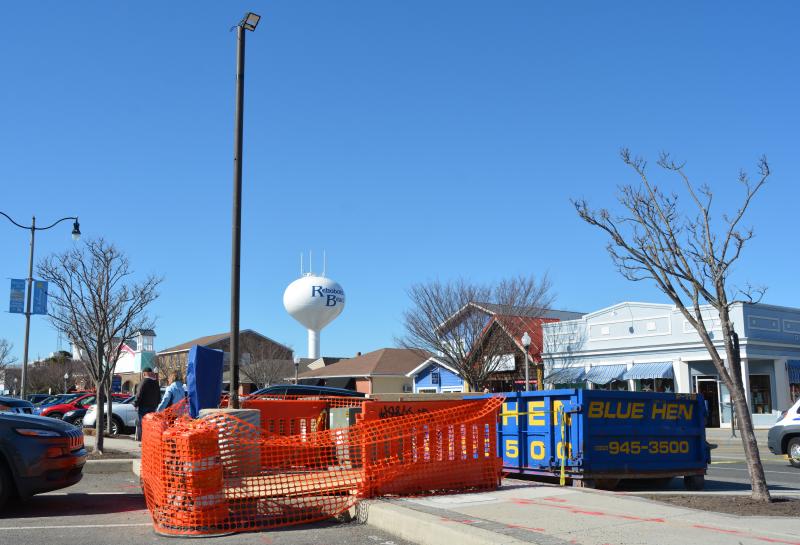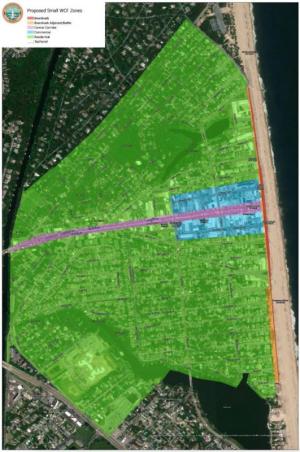Rehoboth considering wireless antenna design zones
As part of the continued rewrite of city code related to installation of wireless antennas, Rehoboth Beach is considering the implementation of five design zones throughout town. Each zone would have a list of preferred aesthetics.
Julie Elias, CTC Technology wireless siting manager and project analyst, has been the consultant working with the city through the rewrite. During a meeting Feb. 7, she said creating the zones gives the telecommunications companies a clear list of requirements before even approaching the city about new antennas.
As proposed, the five zones would be residential, commercial, central corridor, Boardwalk and Boardwalk adjacent. In each zone, the code provides the order of priority from most preferable to least preferable design.
For example, in residential, the most preferable design option would be for a company to colocate its antenna on an existing wooden utility pole, with the conduit and any accessory equipment painted to match the existing pole. The next preferable options would be for the company to replace an existing pole, with accessory equipment painted to match. Finally, the least preferable option would be to install a new decorative pole that is ‘aesthetically consistent’ with existing poles. If there are no existing metal light poles or decorative poles, the wording calls for a new pole to be installed in line with other poles on the block. The residential zone makes up a significant portion of the entire city.
In the commercial zone, the most preferable antenna option is placement on a commercial building rooftop, and equipment must be mounted in an antenna enclosure the same color or design as the building.
In the central corridor zone, which is basically Rehoboth Avenue, the proposed wording would only allow for new antennas to be collocated on wireless support structures in the median, similar to what AT&T did a couple years ago with its antennas when it replaced existing street lights.
The Boardwalk adjacent zone, north of Hickman Street, would be 30 feet from the west edge of the Boardwalk. From Hickman Street south, the zone would be 90 feet from the west edge of the Boardwalk.
The Boardwalk zone essentially means equipment replacing the light fixtures on the east side of the Boardwalk.
The creation of the zones isn’t the only code section the city is examining. As proposed, the height of the antenna canister couldn’t be taller than three feet; ground-mounted equipment couldn’t exceed 36 inches in any dimension; pole-mounted equipment couldn’t be larger than 12 cubic feet in volume, wider than 24 inches or protruding more than 12 inches; and an antenna would have to be 30 feet from the nearest residential dwelling, 20 feet from the nearest commercial dwelling, 250 from the nearest elementary school and park, 300 feet from another antenna from the same company, and 100 feet from an antenna of a different company.
Use of best available technology
Commissioners also continued their discussion on wording related to telecommunication companies using the best available technology when installing antennas. During the last meeting, commissioners said they would like to see the wording in the code. However, the consultant has said it’s not necessary.
During the Feb. 7 meeting, Mayor Stan Mills read aloud a letter from Bonnie Metz, Verizon director of state government affairs. The letter said the city doesn’t have the right to tell Verizon, or any telecommunications company, what technology to use. Mills said AT&T supports what Verizon said.
Elias said she and her colleagues aren’t aware of any municipality that has undertaken the task of writing language that would require the use of best available technology, which would mean it would have to be a customized project and take an enormous effort.
Resident Michael Strange called the letter from Metz a scare tactic and said including the language allows the city to be up to date all the time. It’s no more burdensome on the companies than other infrastructure improvements, he said.
Ultimately, the commissioners directed the consultant to craft wording that has the weight of the phrase “best available technology,” without using that phrase. No time frame was set for when the issue would be discussed again.
Chris Flood has been working for the Cape Gazette since early 2014. He currently covers Rehoboth Beach and Henlopen Acres, but has also covered Dewey Beach and the state government. He covers environmental stories, business stories and random stories on subjects he finds interesting, and he also writes a column called Choppin’ Wood that runs every other week. He’s a graduate of the University of Maine and the Landing School of Boat Building & Design.






















































